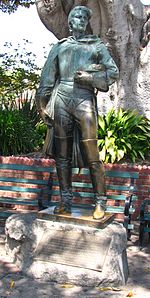Italian American Museum of Los Angeles
Buildings and structures in Downtown Los AngelesEl Pueblo de Los Ángeles Historical MonumentEthnic museums in CaliforniaHistory museums in CaliforniaItalian-American culture in Los Angeles ... and 2 more
Italian-American museumsMuseums in Los Angeles

The Italian American Museum of Los Angeles (Italian: "Museo Italo Americano di Los Angeles" and abbreviated IAMLA) is a museum located in downtown Los Angeles, California, and is part of the El Pueblo de Los Ángeles Historical Monument. It is dedicated to the history, experience and continuing contributions of Italian Americans and Italians in Southern California and the United States, and is the first such museum in Southern California. The museum opened in 2016 and has presented historical exhibits on Italians in Los Angeles, including Sunshine and Struggle and a variety of educational and cultural events.
Excerpt from the Wikipedia article Italian American Museum of Los Angeles (License: CC BY-SA 3.0, Authors, Images).Italian American Museum of Los Angeles
El Pueblo Los Angeles Plaza Historic Park, Los Angeles Downtown
Geographical coordinates (GPS) Address Nearby Places Show on map
Geographical coordinates (GPS)
| Latitude | Longitude |
|---|---|
| N 34.056681 ° | E -118.23809 ° |
Address
Biscailuz Building
El Pueblo Los Angeles Plaza Historic Park
90012 Los Angeles, Downtown
California, United States
Open on Google Maps











